1998 CADILLAC SEVILLE change wheel
[x] Cancel search: change wheelPage 229 of 378
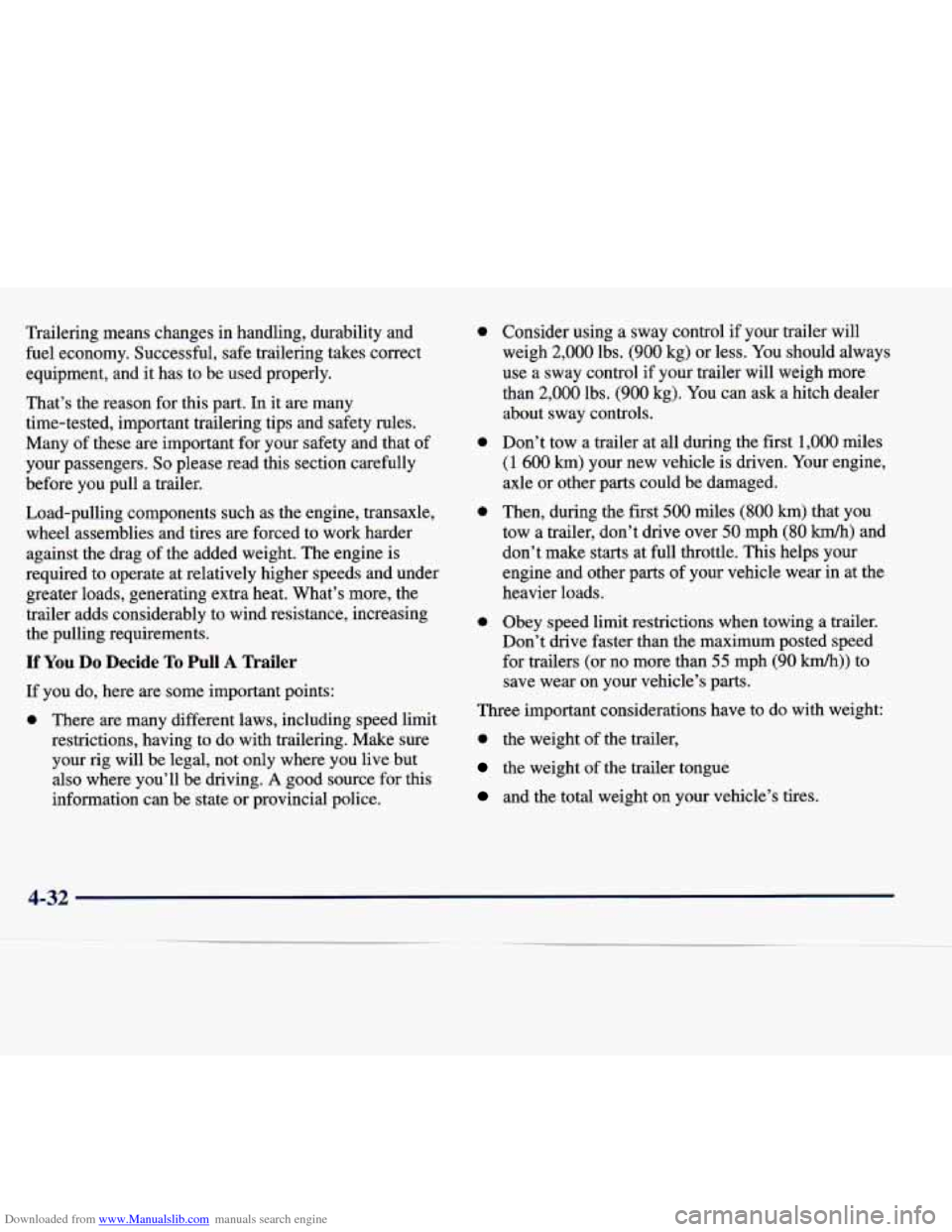
Downloaded from www.Manualslib.com manuals search engine Trailering means changes in handling, durability and fuel economy. Successful, safe trailering takes correct
equipment, and it has to be used properly.
That’s the reason for this part. In it are many
time-tested, important trailering tips and safety rules.
Many of these are important for your safety and that of
your passengers.
So please read this section carefully
before you pull a trailer.
Load-pulling components such as the engine, transaxle,
wheel assemblies and tires are forced to work harder against the drag of the added weight. The engine is
required to operate at relatively higher speeds and under
greater loads, generating extra heat. What’s more, the
trailer adds considerably to wind resistance, increasing
the pulling requirements.
If You Do Decide To Pull A Trailer
If you do, here are some important points:
0 There are many different laws, including speed limit
restrictions, having to do with trailering. Make sure your rig will be legal, not only where you live but
also where you’ll be driving.
A good source for this
information can be state or provincial police.
0
0
0
0
Consider using a sway control if your trailer will
weigh
2,000 lbs. (900 kg) or less. You should always
use a sway control if your trailer
will weigh more
than
2,000 lbs. (900 kg). You can ask a hitch dealer
about sway controls.
Don’t tow a trailer at all during the first
1,000 miles
(1 600 km) your new vehicle is driven. Your engine,
axle or other parts could be damaged.
Then, during the first
500 miles (800 km) that you
tow a trailer, don’t drive over
50 mph (80 km/h) and
don’t make starts at full throttle. This helps your
engine and other parts of your vehicle wear in at the
heavier loads.
Obey speed limit restrictions when towing a trailer.
Don’t drive faster than the maximum posted speed
for trailers (or no more than
55 mph (90 km/h)) to
save wear on your vehicle’s parts.
Three important considerations have to do with weight:
0 the weight of the trailer,
the weight of the trailer tongue
and the total weight on your vehicle’s tires.
4-32
Page 234 of 378
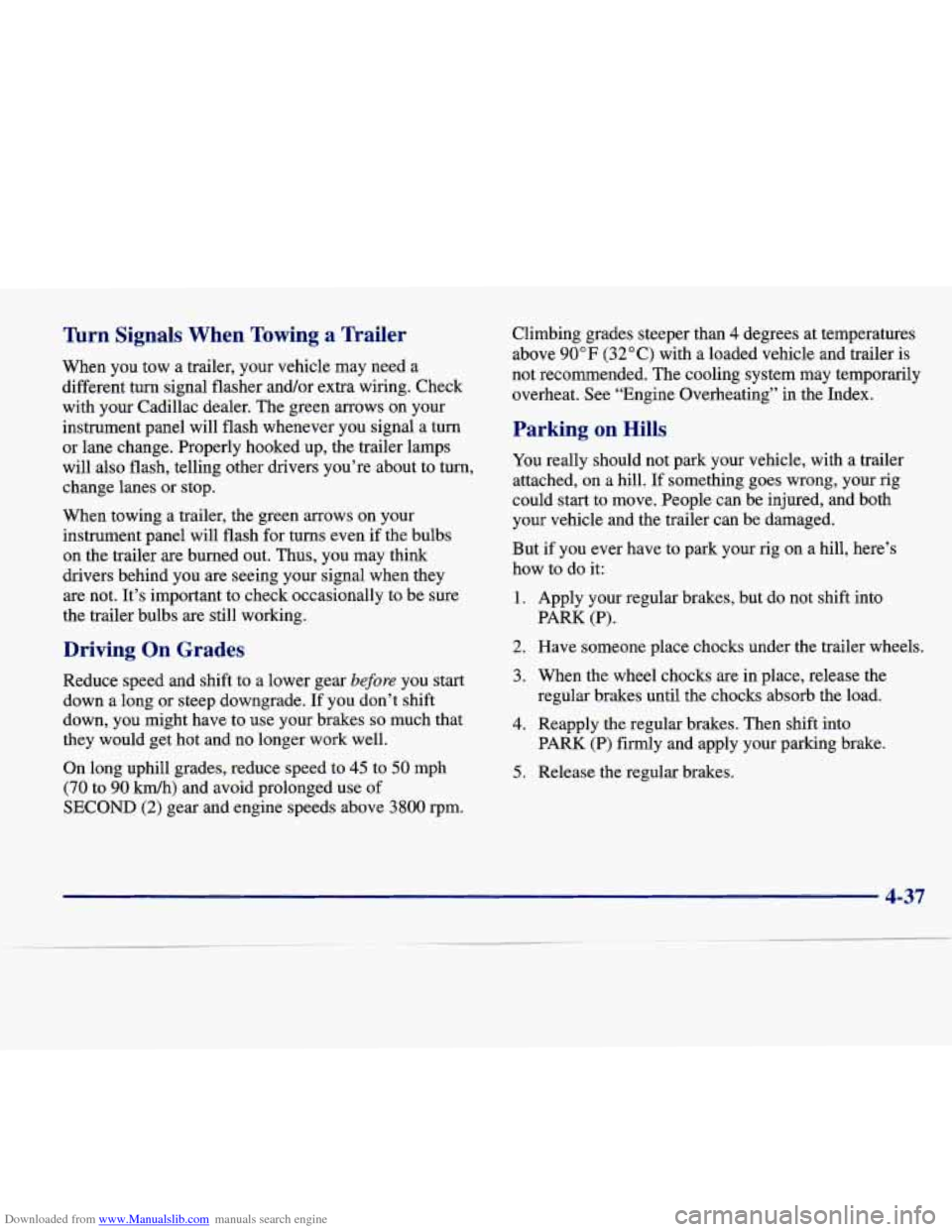
Downloaded from www.Manualslib.com manuals search engine Turn Signals When Towing a Trailer
When you tow a trailer, your vehicle may need a
different turn signal flasher and/or extra wiring. Check
with your Cadillac dealer. The green arrows on your
instrument panel will flash whenever you signal a turn
or lane change. Properly hooked up, the trailer lamps
will also flash, telling other drivers you’re about to turn,
change lanes or stop.
When towing a trailer, the green arrows on your instrument panel will flash for turns even if the bulbs
on the trailer are burned out. Thus, you may think
drivers behind you are seeing your signal when they
are not. It’s important to check occasionally to be sure
the trailer bulbs are still working.
Driving On Grades
Reduce speed and shift to a lower gear before you start
down a long or steep downgrade. If you don’t shift
down, you might have to use your brakes
so much that
they would get hot and no longer work well.
On long uphill grades, reduce speed to 45 to 50 mph
(70 to 90 km/h) and avoid prolonged use of
SECOND (2) gear and engine speeds above 3800 rpm. Climbing grades steeper than 4 degrees at temperatures
above
90°F (32 “C)
with a loaded vehicle and trailer is
not recommended. The cooling system may temporarily
overheat. See “Engine Overheating” in the Index.
Parking on Hills
You really should not park your vehicle, with a trailer
attached, on a hill. If something goes wrong, your rig
could start to move. People can be injured, and both
your vehicle and the trailer can be damaged.
But if you ever have to park your rig on a hill, here’s
how to do it:
1. Apply your regular brakes, but do not shift into
PARK (P).
2. Have someone place chocks under the trailer wheels.
3. When the wheel chocks are in place, release the
regular brakes until the chocks absorb the load.
4. Reapply the regular brakes. Then shift into
PARK (P) firmly and apply your parking brake.
5. Release the regular brakes.
4-37
Page 245 of 378
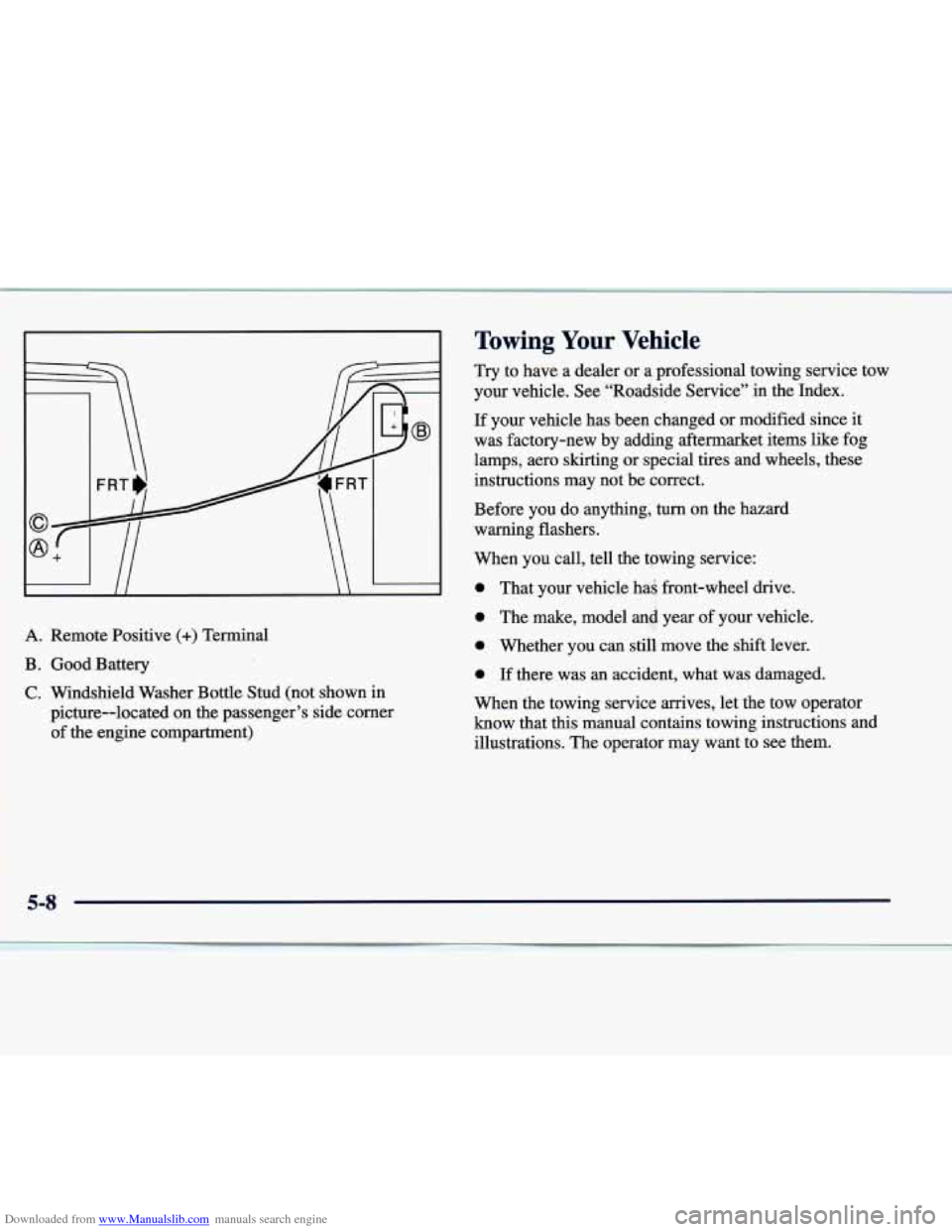
Downloaded from www.Manualslib.com manuals search engine L II \
A. Remote Positive (+) Terminal
B. Good Battery
C. Windshield Washer Bottle Stud (not shown in
picture--located on the passenger’s side corner of the engine compartment)
Towing Your Vehicle
Try to have a dealer or a professional towing service tow
your vehicle. See “Roadside Service” in the Index.
If your vehicle has been changed or modified since it
was factory-new by adding aftermarket items like-fog
lamps, aero skirting or special tires and wheels, these instructions may not be correct.
Before you do anything, turn on the hazard warning flashers.
When you call, tell the towing service:
0 That your vehicle ha$ front-wheel drive.
0 The make, model and year of your vehicle.
0 Whether you can still move the shift lever.
0 If there was an accident, what was damaged.
When the towing service arrives, let the tow operator
know that this manual contains towing instructions and
illustrations. The operator may want to see them.
Page 261 of 378
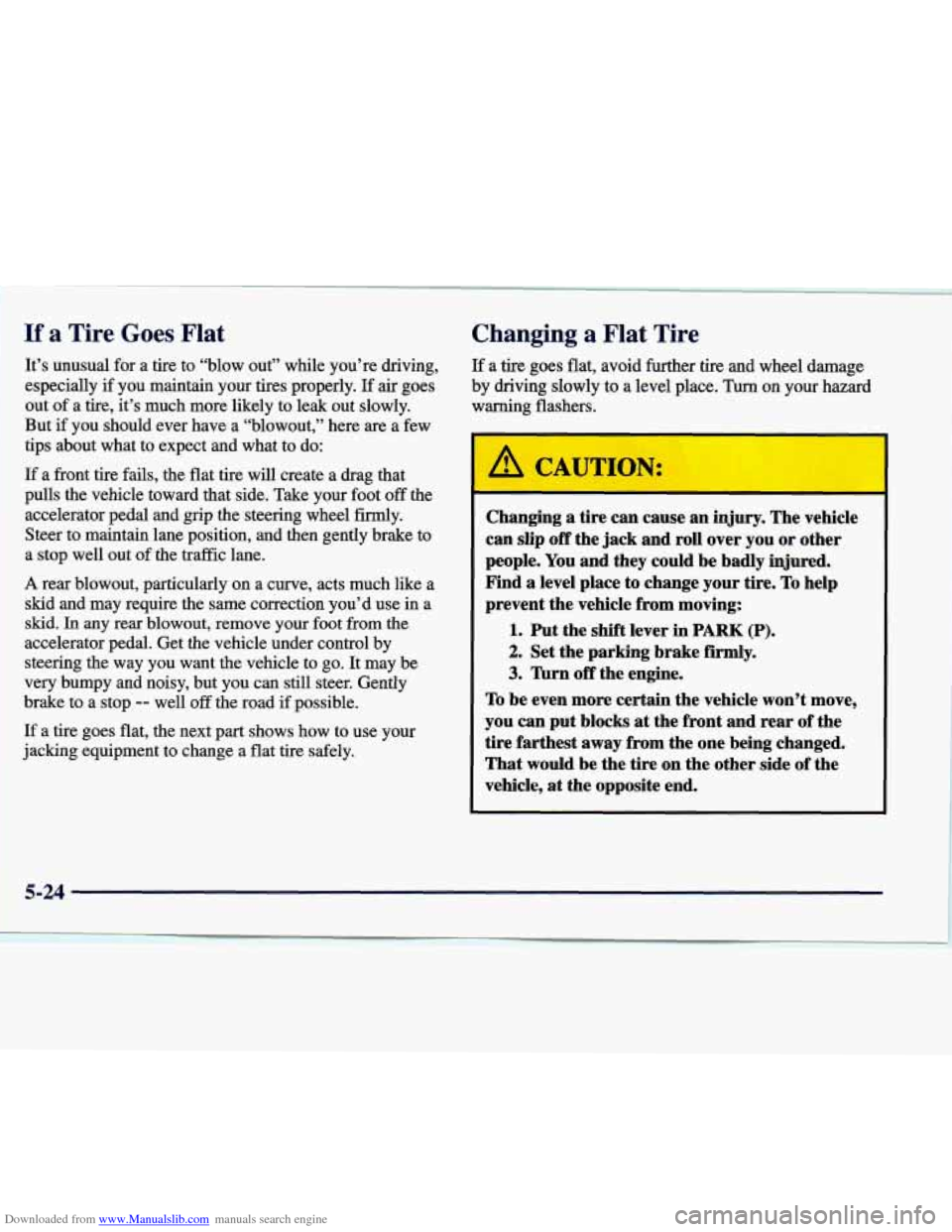
Downloaded from www.Manualslib.com manuals search engine [f a Tire Goes Flat
Changing a Flat Tire
It’s unusual for a tire to “blow out” while you’re \
driving, If a tire goes flat, avoid further tire and wheel d\
amage
especially if you maintain your tires properly.
If air goes by driving slowly to a level place. Turn on your hazard
out
of a tire, it’s much more likely to leak out slowly. warning flash-x
But if you should ever have a “blowout,” here are a few\
tips about what to expect and what to do:
If a front tire fails, the flat tire will create a drag that
pulls the vehicle toward that side. Take your foot
off the
accelerator pedal and grip the steering wheel firmly.
Steer to maintain lane position, and then gently brake to
a stop well out of the traffic lane.
A rear blowout, particularly on a curve, acts much like a
skid and may require the same correction you’d use in a
skid. In any rear blowout, remove your foot from the
accelerator pedal. Get the vehicle under control by steering the way you want the vehicle to
go. It may be
very bumpy and noisy, but you can still steer. Gently
brake to a stop
-- well off the road if possible.
If a tire goes flat, the next part shows how to use your
jacking equipment to change a flat tire safely.
Changing a tire can cause an injury. The vehicle
can slip
off the jack and roll over you or other
people. You
and they could be badly injured.
Find
a level place to change your tire. To help
prevent the vehicle from moving:
1. Put the shift lever in PARK (P).
2. Set the parking brake firmly.
3. ”m off the engine.
To be even more certain the vehicle won’t move,
you can put blocks at the front and rear of the
tire farthest away from the one being changed.
That would be the tire on the other side of the
vehicle, at the opposite end.
5-24
Page 267 of 378
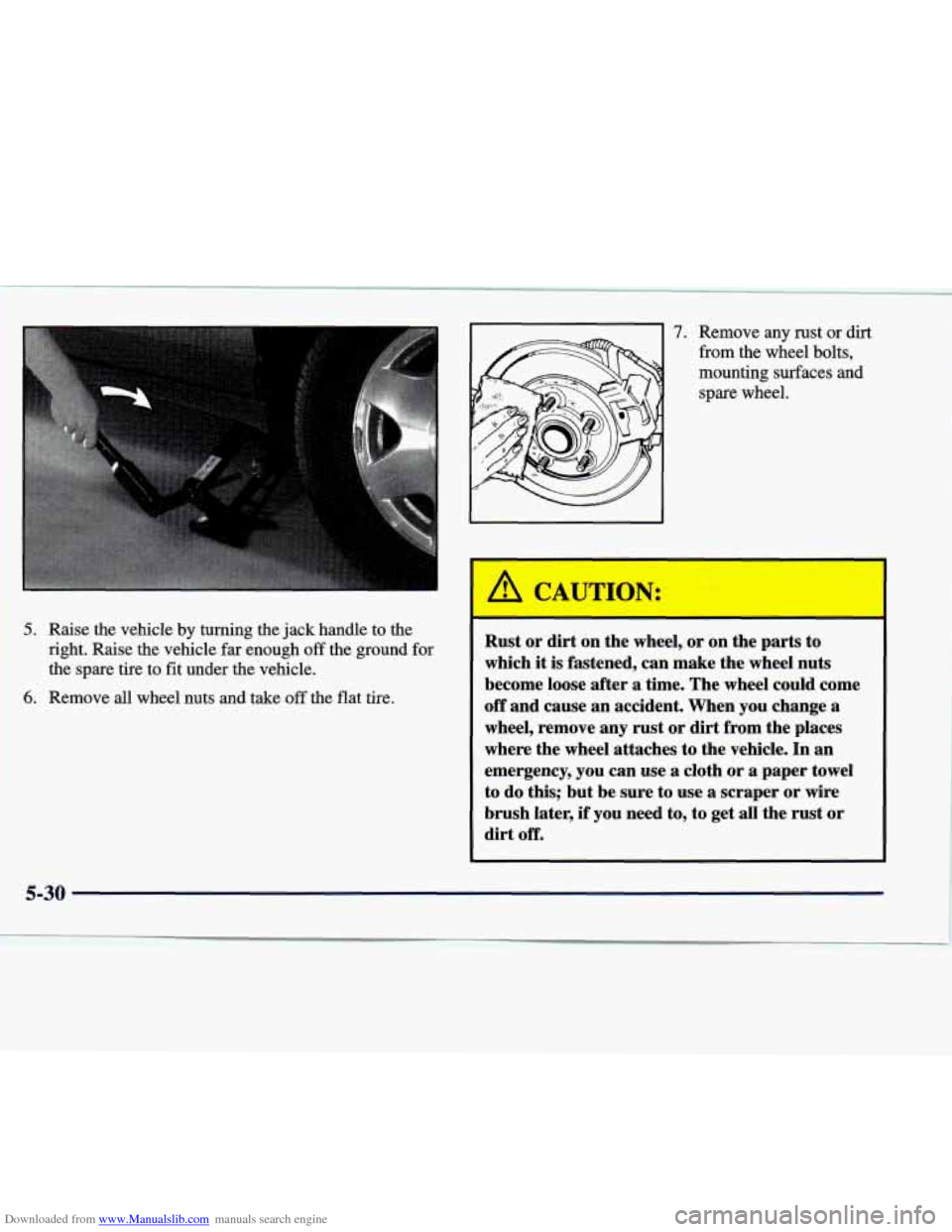
Downloaded from www.Manualslib.com manuals search engine 5. Raise the vehicle by turning the jack handle to the
right. Raise the
vehicle far enough off the ground for
the spare tire to fit under the vehicle.
6. Remove all wheel nuts and take off the flat tire.
1.
~
~~ ~ ~~
~ ~ ~~
Remove any rust or dirt
from the wheel bolts,
mounting surfaces and
spare wheel.
Rust or dirt on the wheel, or on the parts to
which it
is fastened, can make the wheel nuts
become loose after
a time. The wheel could come
off and cause an accident. When you change a
wheel, remove any rust or dirt from the places
where the wheel attaches to the vehicle.
In an
emergency, you can use a cloth or
a paper towel
to do this; but be sure to use a scraper or wire
brush later, if you need to, to get all the rust or
dirt off.
5-30
Page 305 of 378
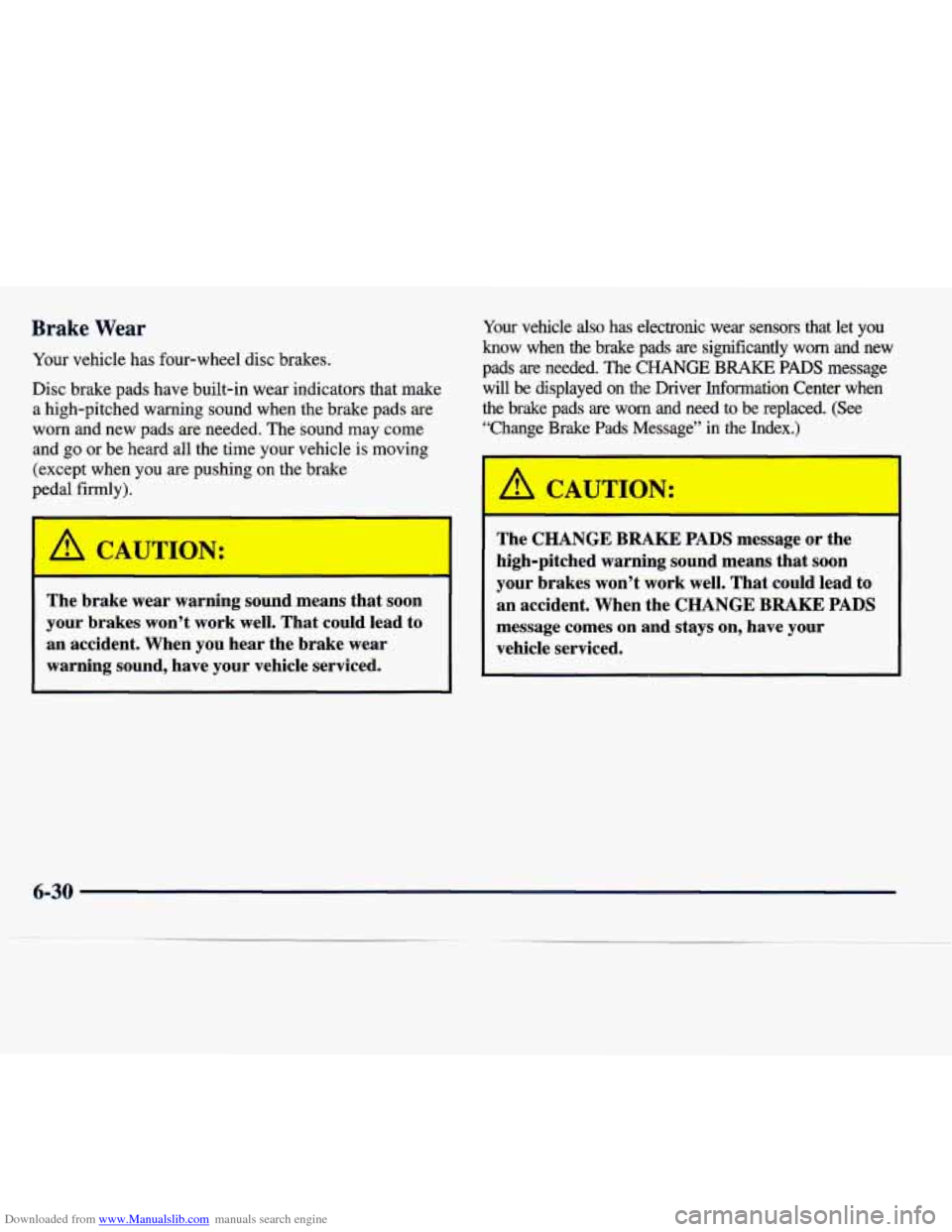
Downloaded from www.Manualslib.com manuals search engine Brake Wear
Your vehicle has four-wheel disc brakes.
Disc brake pads have built-in wear indicators that make
a high-pitched warning sound when the brake pads are
worn and new pads are needed. The sound may come
and
go or be heard all the time your vehicle is moving
(except when you are pushing on the brake
pedal firmly).
r
A CAUTION:
The brake wear warning sound means that soon
your brakes won’t work well. That could lead to
an accident. When you hear the brake wear
warning sound, have your vehicle serviced.
Your vehicle also has electronic wear sensors that let you
know when the brake pads are significantly worn and new
pads are needed. The
CHANGE BRAKE PADS message
will be displayed on the Driver
Information Center when
the brake pads are worn and need
to be replaced. (See
“Change Brake Pads Message” in the Index.)
-
I A CAUTION:
\-I
The CHANGE BRAKE PADS message or the
high-pitched warning sound means that soon
your brakes won’t work well. That could lead to
an accident. When the
CHANGE BRAKE PADS
message comes on and stays on, have your
vehicle serviced.
6-30
Page 306 of 378
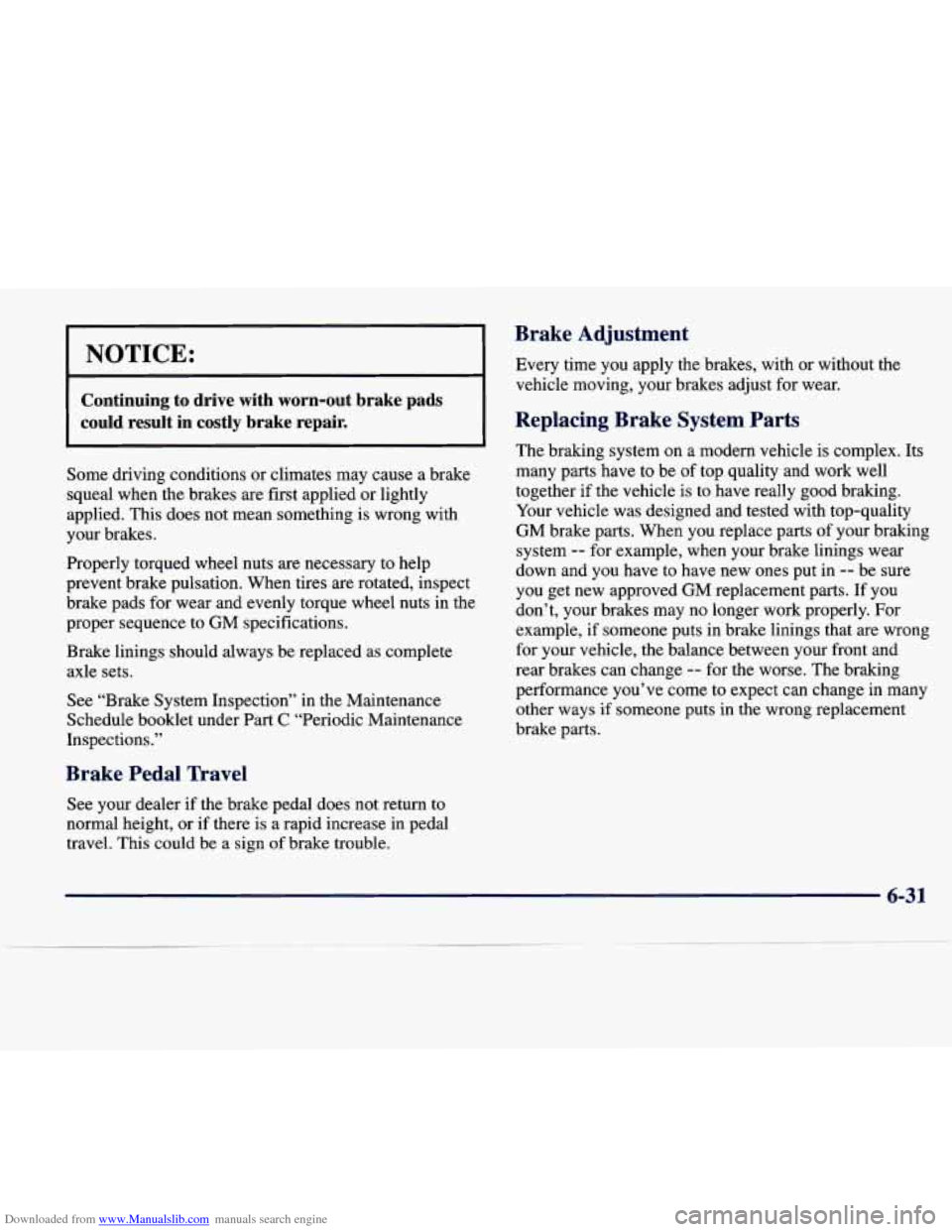
Downloaded from www.Manualslib.com manuals search engine NOTICE:
Brake Adjustment
Every time you apply the brakes, with or without the vehicle moving, your brakes adjust for wear.
Continuing to drive with worn-out brake pads
could result in costly brake repair.
Replacing Brake System Parts
The braking system on a modern vehicle is complex. Its
Some driving conditions or climates may cause a brake
squeal when the brakes are first applied or lightly
applied. This does not mean something is wrong with
your brakes.
Properly torqued wheel nuts are necessary to help
prevent brake pulsation. When tires are rotated, inspect
brake pads for wear and evenly torque wheel nuts in the
proper sequence to GM specifications.
Brake linings should always be replaced as complete
axle sets.
See “Brake System Inspection’’ in the Maintenance
Schedule booklet under Part
C “Periodic Maintenance
Inspections.”
Brake Pedal navel
See your dealer if the brake pedal does not return to
normal height, or if there is a rapid increase in pedal
travel.
This could be a sign of brake trouble. many parts have to be
of top quality and work well
together if the vehicle is to have really good braking.
Your vehicle was designed and tested with top-quality
GM brake parts. When you replace parts
of your braking
system
-- for example, when your brake linings wear
down and you have to have new ones put in
-- be sure
you get new approved GM replacement parts. If you
don’t, your brakes may no longer work properly. For
example, if someone puts in brake linings that are wrong
for your vehicle, the balance between your front and
rear brakes can change
-- for the worse. The braking
performance you’ve come to expect can change in many other ways
if someone puts in the wrong replacement
brake parts.
6-31
Page 319 of 378
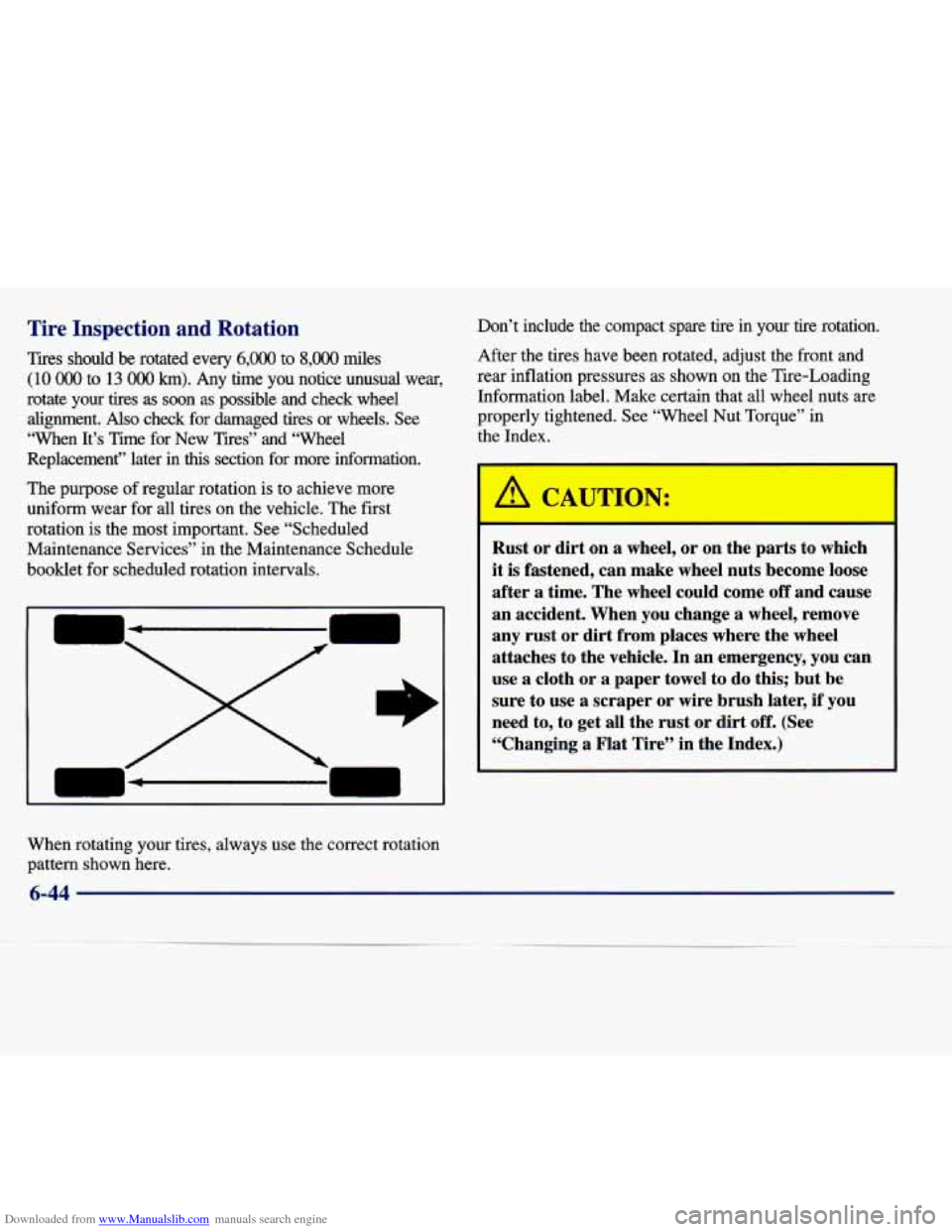
Downloaded from www.Manualslib.com manuals search engine Tire Inspection and Rotation
Tires should be rotated every 6,000 to S,O00 miles
(10 000 to 13 OOO km). Any time you notice unusual wear,
rotate
your tires as soon as possible and check wheel
alignment.
Also check for damaged tires or wheels. See
“When It’s Time for New Tires” and “Wheel
Replacement” later in
this section for more information.
The purpose of regular rotation is to achieve more
uniform wear for all tires on the vehicle. The first
rotation is the most important. See “Scheduled
Maintenance Services” in the Maintenance Schedule
booklet
for scheduled rotation intervals.
When rotating
your tires, always use the correct rotation
pattern shown here. Don’t include the compact spare tire in
your tire rotation.
After the tires have been rotated, adjust the front and
rear inflation pressures as shown on the Tire-Loading Information label. Make certain that all wheel nuts are
properly tightened. See “Wheel Nut Torque” in
the Index.
I
Rust or dirt on a wheel, or on the parts to which
it is fastened, can make wheel nuts become loose
after a time. The wheel could come
off and cause
an accident. When you change
a wheel, remove
any rust or dirt from places where the wheel
attaches to the vehicle. In an emergency, you can
use a cloth or
a paper towel to do this; but be
sure to use
a scraper or wire brush later, if you
need to, to get all the rust or dirt
off. (See
“Changing
a Flat Tire” in the Index.)
1
6-44